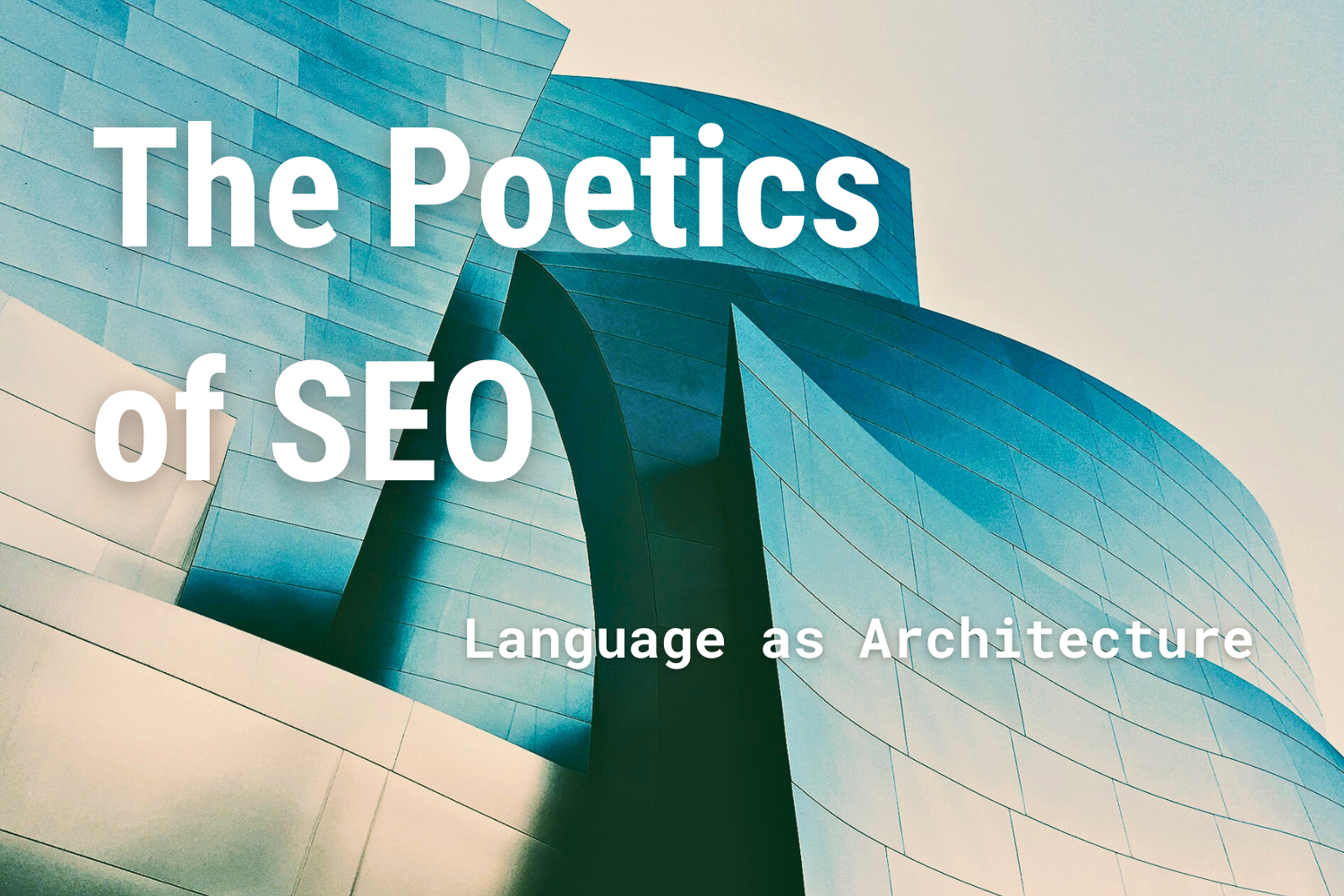The Poetics of SEO: Language as Architecture
I’ve worked in SEO long enough to know it’s rarely about what people think it is. It’s not about gaming algorithms, or stacking keywords, or chasing traffic graphs. At its best, it’s about architecture: about building language that holds meaning the way a structure holds light.
Search engines don’t “read” in the human sense. They crawl, parse, and pattern-match. But what they’re really doing is translating: converting your language into shape, hierarchy, and intent. It’s the same process poets use, the same instinct architects follow. Structure first. Then resonance. Then everything else.
That’s why I think of SEO as a kind of poetics: a system of meaning built from syntax, rhythm, and the invisible logic of discovery.
The Architecture of Meaning
Search isn’t just an algorithmic problem; it’s a semantic one. Search engines are constantly trying to understand how words relate to one another. When I write metadata, craft a title tag, or structure an article, I’m not just signaling relevance; I’m creating an entry point for understanding.
The way you nest headings, the rhythm of your copy, even the relationship between internal links—all of it builds a topology of meaning.
A good site feels like a cathedral: quiet, intentional, proportionate. Every page, every paragraph, every tag carries weight.
The challenge and the beauty is that search engines now interpret this architecture through context, not just keywords. Meaning emerges from relationships, from connections, and from design.
And that’s where art enters the equation.
Semantics and Structure as Art
When you start thinking about SEO semantically, you stop writing for Google and start writing with it.
Semantic SEO asks:
What’s the real question behind this query?
What intent hides between the lines?
What patterns help a machine see what a human already feels?
That’s not optimization; it’s translation. And translation is an art.
The way I see it, headings are rhythm. Internal links are rhyme. Schema markup is subtext. Alt text is a footnote. Each element speaks in its own dialect of clarity.
A page, at its best, is a poem of accessibility: structured so well it disappears.
Crawlers, Context, and Conscious Design
Most of the web is noise. Broken structure. Content without context.
Search crawlers move through it like spelunkers in a cave system, following faint trails of logic and markup.
When they find coherence—proper hierarchy, consistent meaning, human-readable language—they pause. Index. Illuminate.
I think about that often. The crawler as both algorithm and metaphor: a seeker of structure, drawn to signals of care.
If you treat your site like a living system instead of a container for content, search becomes something else entirely. It becomes an ecosystem of meaning, constantly in dialogue with those who build and those who seek.
That’s what good SEO really is: conscious design. Not manipulation, but hospitality.
The Artist’s Advantage
Artists, musicians, writers, and designers are naturally attuned to pattern. They understand rhythm, timing, silence. They know how emotion lives between beats. That’s why I believe creatives are often better equipped for SEO than most marketers. They already understand architecture; they just haven’t seen it expressed in HTML.
When a creative person writes a page title, they feel the weight of every word. When they craft metadata, they understand tone, tempo, subtext. They think in form, not formula.
SEO done this way doesn’t flatten language; it refines it. It teaches precision, pacing, restraint. And that, to me, feels closer to poetry than marketing.
Beyond Optimization: Toward Resonance
There’s a point where optimization stops and resonance begins. That’s where the work gets interesting.
The web is saturated with optimized content that doesn’t mean anything. It checks boxes, hits word counts, and follows templates, but doesn’t hum.
Resonance comes from intent, from writing that carries both structure and soul. It’s what happens when someone lands on your page and feels that they’ve arrived somewhere built by a human being.
That’s what I want my work to do: help people build systems that don’t just perform, but speak. When language becomes architecture, SEO becomes more than a marketing function. It becomes a practice of care.
Closing: Systems of Meaning
SEO, for me, has always been less about ranking and more about anticipating need and intent. It’s a philosophy of structure: how words become systems, how systems become meaning.
If that kind of thinking resonates with you, if you’re a creative professional, brand, or studio that wants to build something intentional, I’d love to talk. We can make something that both people and machines can feel.
FAQs: The Poetics of SEO (For Humans and Machines)
-
It means treating SEO not as a trick or tactic, but as a craft: where structure, meaning, and rhythm work together to create clarity.
-
Architecture gives form to space; SEO gives form to language. Both depend on balance, hierarchy, and proportion.
-
Semantic SEO focuses on meaning and relationships between words rather than exact keyword repetition. It’s how search engines now understand context.
-
Writers, musicians, and artists can use SEO to make their work discoverable without compromising voice. It’s about structuring clarity, not diluting creativity.
-
Headings act as a visual and semantic rhythm, helping readers and crawlers alike understand the logic of a page.
-
Internal links are connective tissue. They show how your ideas relate, guiding both user flow and crawler comprehension.
-
Intent. When language aligns with human curiosity, not just algorithmic demand, the result is trust and recognition.
-
More than ever. Structured, meaningful language helps AI models interpret and represent your ideas accurately.
-
Optimization clarifies expression. Authenticity gives it weight. The balance lies in writing for comprehension, not manipulation.
-
Begin with structure: hierarchy, clarity, and voice. Write for meaning, then refine for machines. It’s not about gaming the system; it’s about communicating within it.
